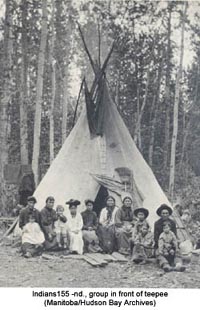

  |
| Home Search Resources & Links Project Team Contact Feedback Site Map Sponsors Help |
|
The PastCulture
The Fur Trade Treaty Five Past Issues The Present The Future Multimedia |
Culture 
One of the Largest Native group's in Canada is The Cree, with over 200,000 registered members and self-governed communities. Cree comes from the French name for the tribe, Kristenaux, said to be a corruption of the French word Christian. It is also an Algonquian word for first people. When speaking their own language the Cree refer to themselves as Ayisiniwok, meaning true men, or Iyiniwok, Eenou, Iynu, or Eeyou, meaning the people.
The Cree People of York Factory First Nation have a proud history of living off the land. Time and time again their way of life has changed due to European contact.
Traditionally the Cree people of York Factory First Nation resided in a vast area that surrounded the York Factory Trading Post, an area that stretched from Port Nelson to Shamattawa, from Shamattawa to Fort Severn, from there to Kaskatamagun, and from Kaskatamagun to Port Nelson. This area was where their roots had been set down. Generation after generation had called this region home. At the time of first contact with European settlers, life was relatively peaceful. However, things would change considerably.
The rich furs were for most white settlers the main incentive to make the long voyage to the new lands of North America. The Trading Post relevant to the history of the Cree peoples of York Factory First Nation is York Fort, which is now called York Factory Trading Post. To read more in dept detail about the Trading Post please view our Fur Trade section of the web site.
With the post in place Native peoples of the region had adapted to a different life style then what they were used to. They now had to co-exist with a culture that they had never encountered before.
Their lives traditionally consisted of the following:
Language
Cree is an Algonquian language that is spoken by more then 45,000 people across Canada. There are five different major dialects: Eastern Cree, Moose Cree, Central/Swampy Cree, Western Plains Cree, and Northern/Woodlands Cree. The dialect spoken in York Factory is Swampy Cree. All five of the Cree dialects are considered to be distinct languages, however, they are all very similar. So a Swampy Cree would most likely be able to converse with a Western or an Eastern Cree.
Food
The Cree people in the Hudson Bay area relied on their hunting, trapping and fishing skills for their food. Berries were also a very important part of their diet when it was the right season. When an animal was killed the whole animal was used, nothing was ever wasted. For instance, when a rabbit was caught only the paws were thrown away and the rest was eaten. Geese were smoked or dried, their feet were dried out and put away, then boiled and eaten at a later time. When winter came it was time to go inland to hunt caribou. The caribou didn't stay along the coast of the Hudson Bay during the winter. Like other hunted animals, none of the caribou was wasted. They would render the grease to make pemmican. Any of the meat, fat and rendered grease was carried in the caribou's stomach, which was properly cleaned before being used. Fish were boiled, and the broth was used as a tea for the people to drink. Sometimes polar bear was eaten, although some people did not like the taste. Once again none of the bear would go to waste, the fat was rendered into oil and the meat was dried. The bones of the animals were broken and put into a pot to boil, the grease and fat was skimmed off and this became broth to drink. It was strained through a cloth to keep the bones out.
Shelter
The Cree Peoples of the York Factory region over the progressing years changed types of dwellings several times. They started off with traditional teepees and then moved into tents and a few stayed in wigwams. From these types of homes they proceeded towards log cabins, and from log cabins to wooden houses made from wooden planks. From these houses they now live in modernized housing.
Back to top of page
|